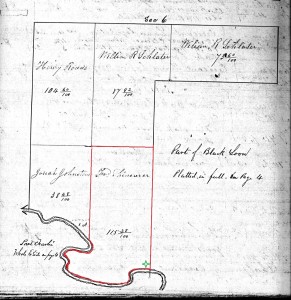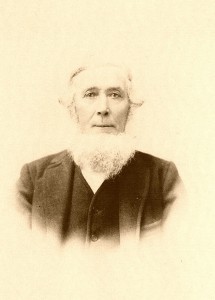He gave his occupation as flourist in the 1860 census. That was a pretty good description of his profession.
He was a successful Germany immigrant. A hard-working, enterprising immigrant who probably arrived in America with very little money, but with a lot of ambition and skill.
This is the story of my great-great-grandfather Friedrich Schinnerer, who owned and ran a flour gristmill. He was indeed a flourist.
As a young man Friedrich learned the trade of miller in Bavaria. He was 25 years old when he immigrated to America in 1849. I am not sure if Friedrich was a miller or a millwright, or maybe he was both. A miller would operate a mill to grind grain into flour, while the millwright could build the mill and the machinery and perform needed repairs.The millwright job could be compared to that of an engineer today.
Perhaps Friedrich was a member of a milling guild in Bavaria before he immigrated. If so, that may have been part of reason he immigrated.
I always wondered why Friedrich did not marry Margaretha Deier in Germany before coming to America. They married two weeks after arriving in America and she gave birth to a daughter about six weeks after their marriage. [1]
Perhaps his homeland and his profession were part of their marriage situation. A couple years ago I attended a lecture at a genealogy conference about German marriage laws and customs and I now wonder if the some of them could apply to Friedrich and Margaretha.
Bavaria proper, not Rhine Pflaz Bavaria, had many marriage restrictions in the 16th-19th centuries. Restrictions included getting permission to marry, marrying outside one’s social or economic class, monetary requirements, restricting the poor from marrying, to name a few. [2]
German craft guilds also had marriage restrictions and they might include: The guild had to approve the marriage. A master had to be married. Journeymen and apprentices were not allowed to marry. Journeymen and apprentices were not allowed to marry until there was an opening in the guild. Journeymen were encouraged to marry the daughter or widow of a guild member. [2] [3] In short, it could take a long time to get the approval for a marriage.
Since most people immigrated because of the economic opportunities in America, Friedrich may have actually had a couple of reasons to come to the new world–personal and financial. We may never know the whole story.
Within two months of their immigration, Friedrich and his new wife settled in Mercer County, Ohio. There, near the town of Shanesville, Friedrich began work in a grist and saw mill owned by John Rhodes. One source indicates it was a also shingle mill. [4]
The German-Lutheran community of Schumm is about six miles by road (about three miles as the crow flies) from the site of Rhodes mill. People traveled with and/or settled near relatives, friends, or friends of friends. So I would not be surprised to learn that someone from the Schumm area sent word back to Bavaria about an opportunity for a miller in this area. Perhaps John Rhodes wanted to sell the mill and move on, which he did not long after Friedrich arrived.
John Rhodes built the water-powered gristmill in 1840 and it was the first flour mill in the township. Friedrich took over operation of the mill in 1849 and agreed to rent the mill from John Rhodes for $400 per year. But before the first year ended Friedrich purchased the mill and 115 acres of land for $3300. Friedrich had only $1000 at the time but he paid the balance from profits he made from the mill. [5] The deed for the land and the mill was signed June of 1850. [6]
The mill was located along the north bank of the St. Marys River, on River Trail Road, where it turns to the north. It was about two miles west of Shanesville, known today as the village of Rockford, in Dublin Township. River Trail Road extends into Van Wert County, where it is named Rhodes Mill Road. That is a pretty descriptive road name. The mill was a little less than a mile south of the Van Wert County line.

Friedrich Schinnerer property, Dublin Township, 1853. The mill was located at green star, by the St. Marys River.
The 1853 Mercer Platt book gives the following description of Friedrich’s land and mill: SW fraction 1/4 of Section [6], 115; excellent land situated on a county road, 20 acres of plow land well cleared, 3 old cabin houses; one grist mill 26 by 36, 2 burrs; sawmill attached. The value of the mill was a $1200 and the value of the land cabins was $705, for a total value of $1905. [7] I imagine Friedrich and Margaretha lived in one of those cabin homes, close to the mill. He was doing quite well and had only been in the country about four years.
In 1860 his real estate was valued at $8,000 and his personal estate at $2,000. By 1860 Friedrich had an apprentice at the mill, John Shum, 18, probably the son of Georg Martin and Anna Maria (Pflüger) Schumm, who died in the Civil War. [8]
Yes, Friedrich was doing quite well in America.
Next: More about Schinnerer’s Mill.
[1] Karen Miller Bennett, CGsm, “Friedrich Schinnerer—Immigration & 1st Marriage,” Karen’s Chatt, 7 February 2014 (https://karenmillerbennett.com/schinnerer/friedrich-schinnerer-immigration-marriage/).
[2] F. Warren Bittner, CGsm, “German Marriage Laws and Customs,” NGS 2012 Family History Conference, 9-12 May 2012, Cincinnati, Ohio. An outline of this presentation is at http://www.hgftx.org/Data-4afw4/Document-Library/1151929287.pdf .
[3] Another good source of information about Bavarian marriage customs: http://familysearch.org/learn/wiki/en/Bavarian_Marriage_Customs,_Laws,_and_Trends_of_Illegitimacy
[4 History of Van Wert County, Ohio and Representative Citizens, (Chicago, Illinois : Richmond & Arnold, 1906), p. 629.
[5] Sutton, History of Van Wert and Mercer Counties, Ohio, (1882; reprint, Mt. Vernon, Indiana : Windmill Publications, Inc., 1991), 254.
[6] Mercer County Deeds Book P:25, Recorder’s Office, Courthouse, Celina, Ohio. John Rodes to Frederick Schinnerer, 25 June 1850.
[7] Mercer County, Ohio, 1853 Plat Book, Dublin Township, Section 6, p. 315 A & B, Fredrick Schinnerer; Recorder’s Office, Celina.
[8] 1860 U.S. Census, Dublin, Mercer County, Ohio, p. 42, dwelling 296, family 300, Frederick Shimer; digital image by subscription, Ancestry.com (http://www.ancestry.com : accessed 5 February 2014); from Family History Library Microfilm 805009, from National Archives microfilm M653, roll 1009.




5 comments
Skip to comment form
The power of the guilds in the old world has often been overlooked in our history. In fact the relationship to servitude and many other grossly unfair labor practices is usually glossed over lightly if even noted at all in our eagerness to blame the rich or royal segments of society. No one seems to connect the poor education systems of the time with the power that it garnered for those with even the smallest skills or knowledge. Look at how fearful such groups were of education, even the American slave owners were smart enough to know that educating slaves was a sure course for trouble. Where do you suppose they learned these tactics?
Love the term “flourist” – if one didn’t know anything else about him they might have assumed he was a florist!
Author
I know! At first I did not know what the census taker meant by the term.
I never heard of a “flourist” until reading your post. Your g-g-grandfather sounds like a real pioneer, a man determined to build a better future for his new family even if it meant coming to a new country. Looking forward to your future posts about this “flourist.”
Author
Thank you!